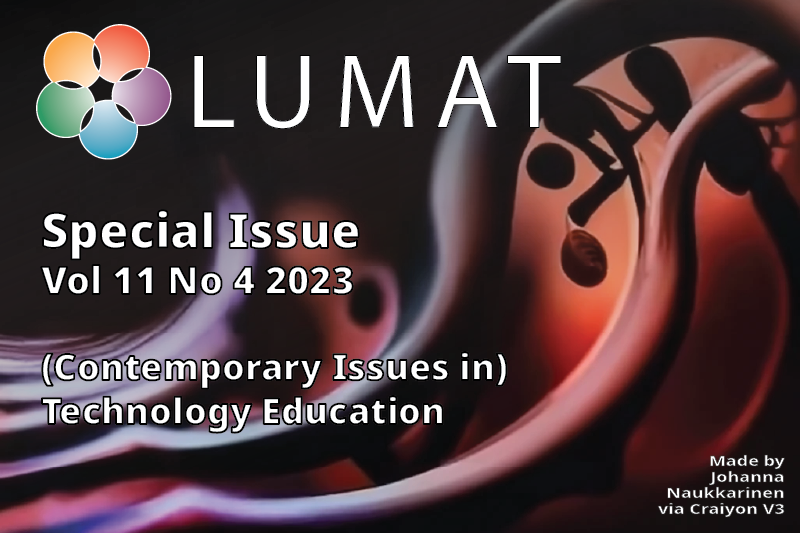What is technology education?
DOI:
https://doi.org/10.31129/LUMAT.11.4.2207Keywords:
technology education, learningAbstract
The trouble with answering the question ‘What is technology education?’ is that there is no precise and well-defined answer. This is attributable, in one important respect, to the breadth of subject domains that exist in technology education today. These vary across the world but may include woodwork, metalwork, working in plastics, technical drawing or graphic communication, CAD, electronics, pneumatics, mechanics, design or learning about the concept of becoming technologically literate. Each of these subject domains tends to be taught independently from one another and assessed likewise. You cannot teach and assess technical drawing in a woodwork or metalwork classroom setting. This particular issue has now become further confused with the introduction of STEM education.
References
Bergós, J. (2018, 04 16). Gaudí and Teamwork: His Artisan Collaborators. Retrieved 12 25, 2022, from Blog Sagrada Família: https://blog.sagradafamilia.org/en/divulgation/gaudi-and-his-artisan-collaborators/
Bogue, R. (2008). Search Swim and See: Deleuze's Apprenticeship in Signs and Pedagogy of Images. In I. Semetsky, Nomadic Education: Variations on a Theme by Deleuze and Guattari (pp. 1-16). Rotterdam: Brill. DOI: https://doi.org/10.1163/9789087904135_002
Challoner, J. (2011). 1001 Inventions that Changed the World. London: Cassell Illustrated.
Dakers, J., R. (2023). A Nomadic Pedagogy About Technology: Teaching the Ongoing Process of Becoming Ethnotechnologically Literate. Brill Publishers. Leiden - Boston. DOI: https://doi.org/10.1163/9789004537002
Deleuze, G. (2004). Difference and Repetition. (P. Patton, Trans.) London and New York: Continuum.
Deleuze, G., & Guattari, F. (1994). What is Philosophy. (H. Tomlinson, & G. Burchell, Trans.) New York: Columbia University Press.
Dreyfus, A. (2001). On the Internet: Thinking in Action. London and New York: Routledge.
Grosz, E. (2004). The Nick of Time: Politics, Evolution, and the Untimely. Durham and London: Duke University Press. DOI: https://doi.org/10.1515/9780822386032
Jagodzinski, J. (2017). A Critical Introduction to What Is Art Education? In J. Jagodzinski, What is Art Education? (pp. 1-61). New York: Palgrave MacMillan. DOI: https://doi.org/10.1057/978-1-137-48127-6_1
Mahoney, P. G. (2008, 08 07). Industrial Design: Design the Dyson Way. Retrieved 01 02, 2023, from Machine Design: https://www.machinedesign.com/news/article/21817656/industrial-design-design-the-dyson-way
Roffe, J. (2010). Mutiplicity. In A. Parr, The Deleuze Dictionary: Revised Edition (pp. 181-182). Edinburgh: Edinburgh University Press.
Semetsky, I. (2006). Deleuze, Education and Becoming (Kindle Edition). Rotterdam: Sense Publishers. DOI: https://doi.org/10.1163/9789087900946
Wasser, A. (2017). How Do We Recognise Problems? Deleuze Studies, 11(1), 48-67. DOI: https://doi.org/10.3366/dls.2017.0251
Williams, J. (2003, 2013). Gilles Deleuze: Diffrence and Repetition: A Critical Introduction and Guide. Edinburgh: Edinburgh University Press. DOI: https://doi.org/10.1515/9780748668946
Downloads
Published
How to Cite
Issue
Section
Categories
License
Copyright (c) 2024 John R. Dakers

This work is licensed under a Creative Commons Attribution 4.0 International License.










